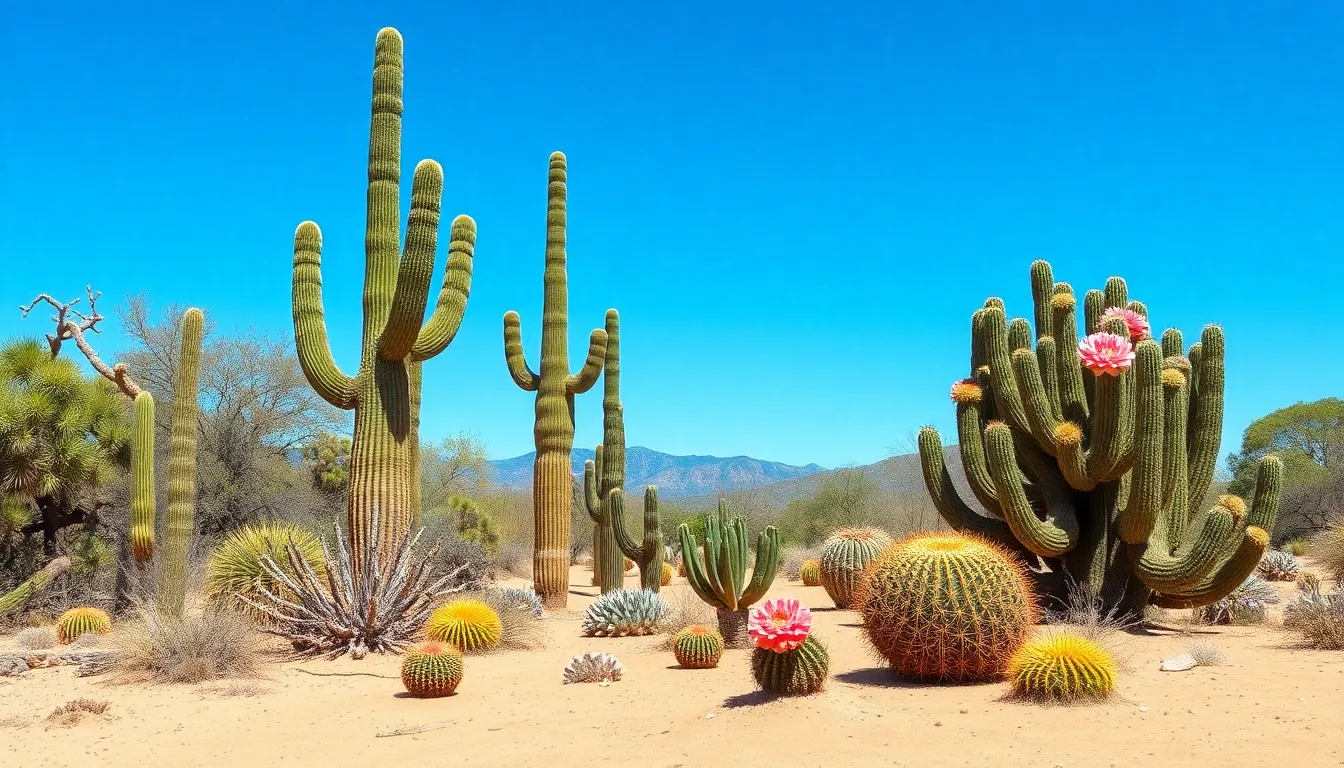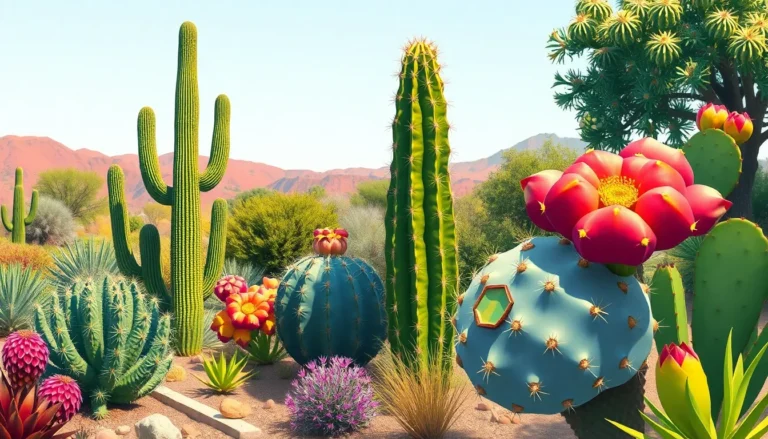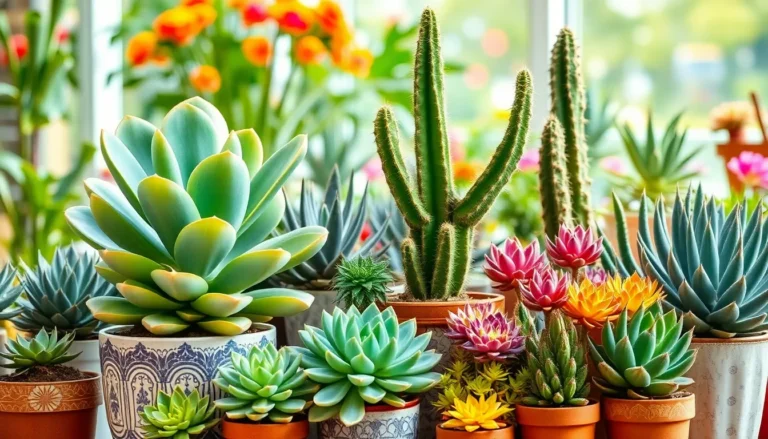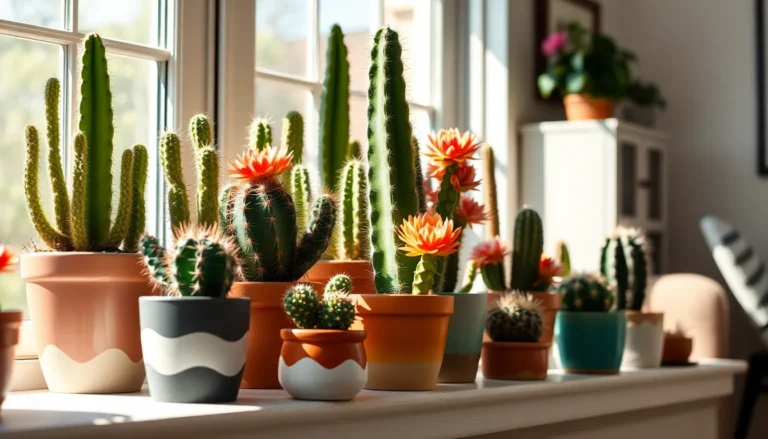In the heart of arid landscapes, desert cacti stand tall and proud, defying the odds of survival. These spiky wonders aren’t just nature’s way of saying “don’t touch,” they’re also fascinating marvels that have adapted to thrive in the harshest conditions. Ever wondered how these prickly plants manage to look so good while living in a sauna?
Desert Cacti
Desert cacti feature unique adaptations that allow them to thrive in arid environments. These plants possess thick, fleshy stems that store water, which is crucial for survival in regions with minimal rainfall. Spines replace leaves in most cacti, reducing water loss through transpiration while providing protection from herbivores.
Photosynthesis occurs in stems, enabling them to convert sunlight into energy efficiently. Various species exhibit different growth patterns. For example, the Saguaro cactus (Carnegiea gigantea) can reach heights of up to 40 feet, while the smaller Echinocactus species rarely exceed a foot in height.
Root systems also vary among desert cacti. Shallow roots spread widely to absorb rain quickly, while deep roots reach underground water sources. The adaptability to both strategies enhances moisture retention during sporadic rain events.
Flowering is another remarkable aspect of desert cacti. Many species produce vibrant, colorful blooms that attract pollinators like bees and birds. The flowers often open at specific times, maximizing the chances of successful pollination. Some cacti can produce fruit that provides nourishment for wildlife, further playing a role in the desert ecosystem.
Reproduction occurs both sexually, through seed production, and asexually, through offsets or cuttings. Seeds can remain dormant for years, only germinating when conditions become favorable. This resilience ensures the continuation of cacti even in inhospitable environments.
Overall, desert cacti exhibit a complex interplay of morphological and physiological traits. Their survival strategies reflect a deep-rooted connection to their harsh surroundings. Understanding these attributes contributes to appreciating the unique biodiversity of desert ecosystems.
Types of Desert Cacti

Desert cacti include various species with distinct characteristics suited for arid conditions. These plants illustrate remarkable diversity and adaptation.
Common Species
Saguaro cactus stands as one of the most recognizable species, growing to heights of up to 40 feet. The Organ Pipe cactus thrives in clusters and can reach heights of 20 feet. Barrel cacti, with their round shapes, store substantial water and can bloom spectacularly with vibrant flowers. Cholla cacti, known for their segmented stems, feature spines that easily detach and can cause irritation. Each of these species plays a vital role in their ecosystems, providing habitat and food for numerous desert inhabitants.
Unique Varieties
Echinopsis terscheckii, or the Argentine giant cactus, showcases unique features, reaching heights of 40 feet and exhibiting large, showy flowers. The Peyote cactus contains psychoactive properties, making it spiritually significant. Exploring the Corphalia genus reveals cacti that grow in intricate, twisted formations adapted for specific desert environments. Additionally, the Christmas cactus, although usually found in cooler climates, can also be discovered in some desert regions, exhibiting stunning red and pink blooms. These unique varieties contribute significantly to the biodiversity within desert ecosystems.
Adaptations to Desert Life
Desert cacti showcase remarkable adaptations essential for life in arid environments. These features enhance their ability to thrive despite extreme conditions.
Water Conservation
Thick, fleshy stems play a crucial role in water storage. Stored moisture sustains the cactus during prolonged dry spells. Spines, which replace leaves, reduce surface area, effectively minimizing water loss through transpiration. Additionally, some species display a waxy coating, further preventing evaporation. Shallow root systems enable quick absorption of rainfall, while deep roots access underground water sources. Collectively, these adaptations optimize water utilization.
Temperature Regulation
Desert cacti adapt to extreme temperature fluctuations effectively. They utilize a specialized form of photosynthesis called CAM (Crassulacean Acid Metabolism) that allows them to absorb carbon dioxide at night, reducing water loss during hot days. Insulating structures, such as spines, shield the plant from intense sunlight. Furthermore, the light color of certain cacti reflects solar radiation. Together, these strategies help maintain a stable internal temperature, allowing cacti to endure the harsh desert climate.
Ecological Importance of Desert Cacti
Desert cacti play a crucial role in sustaining desert ecosystems. They provide essential resources for various wildlife and contribute to soil health.
Habitat for Wildlife
Cacti create vital habitats for numerous species. Birds often use them for nesting, while small mammals seek shelter among their spines. Pollinators, like bees and butterflies, are attracted to the vibrant flowers of many cacti, ensuring successful reproduction. Additionally, larger mammals, including deer and javelinas, rely on cactus fruits as a food source, especially during dry seasons. Each species of cactus, from the tall Saguaro to the compact Barrel cactus, offers unique benefits, fostering diverse ecological interactions.
Soil Stabilization
Cacti also contribute significantly to soil stabilization. Their extensive root systems prevent erosion, maintaining soil structure. Some cacti, with their shallow roots, quickly absorb rainwater, promoting moisture retention in arid environments. This moisture support aids surrounding plants, enhancing overall biodiversity. Furthermore, decaying cactus material enriches the soil with nutrients, facilitating growth for other desert flora. Each cactus type plays a distinct role, ensuring a balanced and resilient desert ecosystem.
Cultivation and Care
Cultivating desert cacti requires understanding their unique needs. These plants thrive in environments that replicate their natural desert habitats.
Growing Conditions
Desert cacti prefer well-draining soil to prevent root rot. Direct sunlight fosters healthy growth; therefore, placing them in locations where they receive at least six hours daily is ideal. Temperatures ranging from 70°F to 100°F support their optimal growth. Watering should occur sparingly, allowing the soil to dry out completely between sessions. Infrequent fertilization with a low-nitrogen cactus food during the growing season enhances vigor and flowering. During the winter, many species benefit from reduced watering and cooler temperatures.
Common Pests and Diseases
Desert cacti face specific threats from pests and diseases. Scale insects often infest these plants, causing yellowing and wilting. Mealybugs also pose a risk, leaving behind a sticky residue. Fungi can develop in overly damp conditions, emphasizing the need for proper drainage. Root rot can occur if watering practices aren’t careful, resulting in plant decline. Regular check-ups for signs of infestation and maintaining proper watering practices can mitigate these issues effectively. Proper air circulation aids in preventing diseases and promotes a healthier cactus environment.
Conclusion
Desert cacti exemplify nature’s ingenuity in adapting to harsh environments. Their remarkable survival strategies and unique features not only ensure their own persistence but also support a diverse range of wildlife. By providing essential resources and stabilizing soil, cacti play a crucial role in maintaining the delicate balance of desert ecosystems.
For those interested in cultivating these resilient plants, understanding their specific needs is vital. With the right care and conditions, anyone can appreciate the beauty and functionality of desert cacti in their own space. Embracing the wonders of these plants fosters a deeper appreciation for the biodiversity and resilience found in some of the planet’s most extreme habitats.




